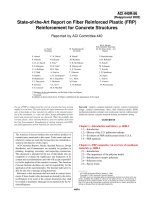Carbon fiber reinforced concrete (Carbocrete)
Bạn đang xem bản rút gọn của tài liệu. Xem và tải ngay bản đầy đủ của tài liệu tại đây (1.41 MB, 28 trang )
Aly
Attia
Ihab
Khalil
Fathy
Abdel
Halim
Mohamed
Mubarak
Presented to: Dr. Mohamed Nagib Abou-Zeid
Carbocrete
The American University In Cairo
School Of Science And Engineering
Department Of Construction and Architectural
Engineering
What is Carbocrete?
History of carbon fibers
Manufacturing of carbon fibers
Carbon fibers in construction
Carbon fibers vs. steel (Properties)
Carbocrete Mixing
Testing
Key properties of Carbocrete
Advantages & disadvantages
Economic aspects
Applications
Conclusion
References
Outline
It is a type of concrete that is reinforced with carbon fibers so it’s also
known as “Carbon Reinforced Concrete”.
It is a new highly stressable lightweight composite construction that
combines special fine grain ultra high-strength concrete and carbon fibers.
It has higher strength than steel with quarter of its weight.
What is Carbocrete?
Carbocrete
In late 1800s, Thomas Edison was the first to use carbon fibers as
filaments for early light bulbs.
It lacked the high tensile strength of today’s carbon fibers; however he
used it because of their high tolerance to heat which made these fibers ideal
for conducting electricity.
History of Carbon Fibers
Thomas Edison
www.biography.com
Filament
en.wikipedia.org
It wasn’t until the late 1950 that high-performance carbon fibers was
manufactured by Mitsubishi Rayon
The USA’s Air Force and NASA didn’t wait develop the carbon fiber
technology and began to use carbon fiber reinforced polymers to replace
heavy metals to allow aircrafts to be lighter and faster.
History of Carbon Fibers (Cont’d)
Carbon fiber aircraft propeller
pics1.this-pic.com
Manufacturing of Carbon
Fibers
Raw carbon fiber is made from either polyacrylonitrile (PAN) or
petroleum coal.
These fossil-fuel- based materials come from either petroleum refining
or natural gas processing
Petroleum coal
www.c-chem.co.jp
PAN
www.c-chem.co.jp
1st: in the thermoset treatment, the fibers are stretched and heated to no more than 400° C
2nd: in the carbonize treatment, the fibers are heated to about 800° C in an oxygen free
environment to remove non-carbon impurities.
3rd: fibers are graphitized; this step stretches the fibers between 50 to 100% elongation, and
heats them to temperatures ranging from 1100° C to 3000° C. The stretching ensures a preferred
crystalline texture, which results in the desired tensile strength.
4th: the last two treatment steps, surface treatment and epoxy sizing, are preformed to enhance
the carbon fiber bonding strength.
Manufacturing of Carbon Fibers
(Cont’d)
Manufacturing of Carbon Fibers
(Cont’d)
PAN Manufacturing Process
www.arrhenius.ucsd.edu
Carbon Fiber in Construction
Carbon fibers are mostly used for repair purposes of old structural element against
shear and flexure failure; the material know as CFRP.
However, in the early 1990s, researches showed that carbon fibers can be used inside
the concrete instead of steel reinforcement showing a significant improvement in the
flexural and tensile strength of concrete.
www.sglgroup.com
Carbon Fibers vs. Steel
Up to 75% lighter
More durable/corrosion-free
5 times higher tensile strength
2 times higher stiffness
Higher temperature tolerance
Comparison of Fiber Strengths
www.innovationskraftwerk.de
Carbon Fibers vs. Steel (Cont’d)
Comparison Between Carbon
Fibers and Steel Fibers
www.innovationskraftwerk.de
Carbocrete Mixing Method
Methods:
Dry mix
Wet mix
Mixing Methods
Carbocrete Mix Design
Mix Design For different CF sizes
Compressive Strength Test
Flexural Strength Test
Slump Test
Testing
Key Properties of Carbocrete
Properties of Carbocete
www.sglgroup.com
Advantages & Disadvantages
Advantages
Disadvantages
High tensile strength:
Smaller cross-sections
Earthquake resistance
Expensive:
High initial cost
Higher durability:
Corrosion-free
Less running cost
Lack of knowledge:
Absence of codes
No implementations yet
Eco-friendly:
Less materials needed for
maintenance and construction.
High thermal conductivity
High HVAC consumption
Low weight:
Easy to handle
Risk of lung cancer in the manufacturing
phase
High flexibility:
More creative architectural design
High abrasion resistance:
Suitable for highway construction
Low coefficient of thermal expansion
High fire resistance
Economic Aspects
www.toray.com
Economic Aspects (Cont’d)
www.utsi.edu
Applications
Limited applications
In 2012, SGL Group launched a competition among
innovative engineers to answer the question "What can I
make from carbon concrete?„
A total of 319 ideas were submited
Applications (Cont’d)
Carbocrete Balcony
www.sglgroup.com
Applications (Cont’d)
Shore protection seashells
www.sglgroup.com
Applications (Cont’d)
Carbocrete bicycle stands
www.sglgroup.com
Applications (Cont’d)
Carbocrete Z-shell
www.sglgroup.com
Applications (Cont’d)
Carbocrete residential/office buildings
www.sglgroup.com
Applications (Cont’d)
Video:
/>









